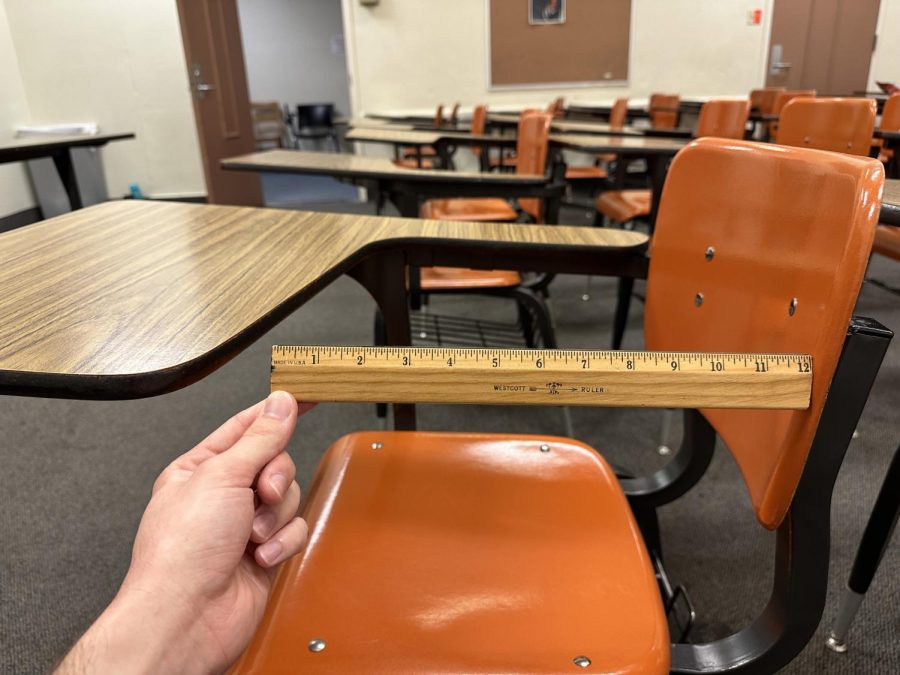Loyola’s classrooms are not suitable for all students
A ruler demonstrates the amount of room that is between the back of the chair and the inside of the desk in a Loyola classroom. Students want Loyola to have more accessible classroom seating.
April 11, 2023
Plus-sized students and students with physical disabilities say Loyola’s classrooms are unsuitable for them.
Loyola freshman Blu DiMarco has dreaded going to class since his first day of college since it is difficult to maneuver in his wheelchair through the aisles of the tight-fitted orange desk chairs that can be found in numerous Loyola classrooms. He said people stare at him because he is one of the only students with a wheelchair on campus. He has skipped classes to avoid the anxieties and frustrations of getting through the obstacle course that is Loyola’s classrooms.
The issue of crammed classrooms is not only a problem for students with physical disabilities but also for plus-sized students who feel they have to squeeze into their desk chairs.
“At the beginning of the first semester, I skipped a lot of my classes simply due to how hard it was to navigate and even sit in the classroom. At this point in my college career, I try not to use my wheelchair, which is, in the long run, so much worse for my body,” DiMarco said. “I try to refrain from being late for class, as most students do, but it’s even worse when being plus-sized in the tiny seats. It’s always followed by some loud disruption that clearly angers my professor and several glances from students.”
These orange desk chairs, commonly found in Bobet Hall, Marquette Hall, and the Communication and Design building, are about 14 inches at their widest length.
Loyola’s classes typically host about 20 students at a time. To utilize small classroom spaces, the orange desk chairs are used but leave minimal walking space between the aisles. This results in a daily struggle for not only students like DiMarco, who use mobility equipment to get around campus, but also for plus-sized students, such as Loyola senior Madi Bowen.
“It is embarrassing to have to suck in my stomach as much as I can to be able to squeeze behind or between students who are already sitting down,” Bowen said. “Oftentimes, I bump into them with my body or I have to walk sideways because I don’t fit walking straight. Then I sometimes hit them with my backpack without knowing.”
Once she has made it to her seat, Bowen said she has to deal with sitting in these claustrophobic chairs for her 50-70 minute classes. She added that she has to squeeze her body into the chair, and her stomach is always touching the desk. Because of this, she said she is losing desk space on the already small desks.
“I have to sit with perfect posture, or else it cuts into me more. I can’t lean on the desk to write at all, so that causes hand and neck pain instead of the pain from pressing my stomach into it,” Bowen said. “The chair itself is too small for my bottom, which means I hang off the sides and am not supported.”
While Loyola has the Office of Accessible Education to accommodate students with disabilities, DiMarco said he feels the university has not done enough to accommodate students with physical disabilities.
“I want Loyola to address these issues and at least attempt to make a change, or maybe even pretend to care,” DiMarco said. “Instead of building a new building, maybe make the classrooms and common areas more accessible.”
However, Director of Loyola’s Office of Accessible Education Andrea Rodriguez explained that in regard to the orange desk chairs, this issue has, in fact, been brought to their attention by a faculty member, but the office needs to hear from a student, so that they can register them in their system and provide the accommodations that the individual needs.
“Physical classroom accommodations normally do not take long to provide if we have contact with the student. It seems in this instance there may be a disconnect between what is needed and what we request students to complete so we can provide the accommodation,” Rodriguez said.
Rodriguez added that if a student does not have documentation of a diagnosis, the office will rely on self-reports for classroom accommodations.
“If the student is not registered with us, we would just need to talk with them to see how we can help,” she said.







